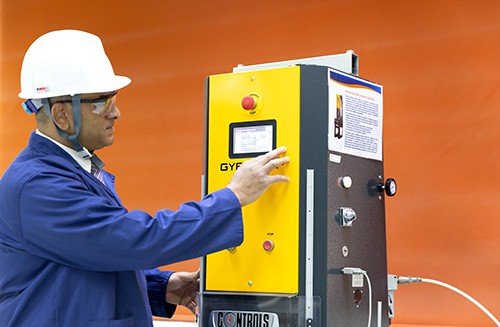Unraveling the Future of Kuwaiti Roads

Over the course of ten days in November 2018, Kuwait found itself on the receiving end of unprecedented storms. In just a single day, parts of the country received as much rain as they typically receive in three months. Roads became impassable rivers; schools closed, and the asphalt deteriorated; the Minister of Public Works pointed out the need to address the infrastructural failures.
“The roads have been deteriorating since 2013,” said Taha Ahmed, Associate Professor at the College of Engineering at Australian University-Kuwait. “But all the solutions presented are not really fixing the problem. They are just painkillers.”
Ahmed has endeavored to tackle these infrastructural challenges head-on in his extensive research project, “Effect of Raveling on the Performance of Hot Mix Asphalt under Arid Climatic Conditions: Case Study in Kuwait.” The phenomenon in question - raveling - occurs when aggregates dislodge themselves from the top layer of the asphalt pavement; this deterioration not only undermines the structural integrity of the roads, but also produces the “flying gravel” that inflicts itself on so many vehicles in Kuwait (especially after a bout of rain). Faced with the task of maintaining roads in an increasingly unstable climate, Kuwait may serve as an ideal (albeit unwilling) laboratory for road design.
Ahmed and his team conducted the project - funded by the Kuwait Foundation for the Advancement of Sciences (KFAS) – in three phases: “Post-mortem Evaluation of In-service Pavements”; “Implementing the Superpave Mix Design Method for Kuwaiti Roads;” and finally, “Performance Life using Mechanistic-Empirical Analysis of Asphalt Mixtures.” The first phase, “Post-mortem Evaluation,” took core samples of five select pavements throughout Kuwait City and assessed them for a range of distress: cracking, potholes, rutting, and raveling.
“Imagine a deterioration curve. For the first few years, it will deteriorate - but not as fast. But at a certain level? There is a breaking point when the pavement cannot really take it anymore,” Ahmed said. “[But] you should reach that point after twenty years. Some places here, reached that point after fifteen years, five years, sometimes three years from their last known maintenance. Can you imagine that?”
Ahmed’s research greatly benefited from the partnership with his graduate alma mater, University of Nevada, Reno; Ahmed’s master’s degree supervisor, Elie Hajj, actually served as the co-investigator (along with Ahmad Said Saad, Ahmed’s colleague at Australian University-Kuwait).
After Ahmed’s undergraduate students collected and prepared both core and laboratory asphalt pavement samples in Kuwait, they would ship them to Aditya Singh and Siththarththan Arunthavabalan, from the laboratory team at University of Nevada, Reno for analysis with specialized advanced equipment not available in Kuwait.
Much of the asphalt’s rapid deterioration can be traced back to moisture damage; excess water ends up stripping away the adhesion between the asphalt’s aggregate and the asphalt binder (bitumen), which results in the raveling. Kuwait’s recent rainstorms, however, have begun to exceed even the “Al-Haddama” rainfall of 1934, when Kuwait witnessed heavy rains amounting to about 300 millimeters, which is three times the usual rainfall amount. It led to the destruction of more than 500 mud houses, displacing 18,000 people. How does one prepare modern roads for this new climactic era? Ahmed addresses a possible solution in the second component of his research, “Implementing the Superpave Mix Design.”
Superpave is an evolution of asphalt chemistry that hopes to replace the “Marshall mix” - the classic asphalt type that coats roads across the world, but whose formula predates World War II. In a long-overdue improvement, Superpave design aims to include traffic load and climate into its formula, to better control the three major stresses that undermine asphalt: permanent deformation, fatigue cracking, and thermal cracking. This new design - already in use in Qatar - is designed to withstand temperatures as high as seventy-six degrees Celsius (sixteen degrees higher than the Marshall mix). This newfound strength depends on a careful combination of four major components: aggregate, binder, air voids, and additives.
One hurdle to implementing this new mix design in Kuwait, however, is that the country actually does not produce the grade of bitumen required to create adequate binder. Missing this critical ingredient, Ahmed’s team mixed the binder with three percent polymer in order to meet Superpave expectations.
There are, of course, other major factors that contribute to road deterioration, such as traffic load - especially in a country where eighty percent of all vehicles are privately owned. One of Ahmed’s previous projects, “Improving the Traffic Flow in Hot Arid Climate Areas by Implementing a Monorail Light Rail Transit System: Case of Kuwait,” suggested that a small length of Gulf Street monorail track could reduce traffic load by as much as fifty percent.
The final stage of Ahmed’s research, “Performance Life using Mechanistic-Empirical Analysis,” attempted to determine if this modified Kuwaiti Superpave mixture would truly be up to the challenge of surviving twenty years in Kuwait’s intense conditions. And in some respects, it absolutely did, particularly with regard to avoiding permanent deformation. Likewise, the new mix could withstand thermal cracking - because, while recent temperatures in Kuwait have reached as high as fifty-four degrees, such heat is still safely within the pavement’s design specifications. (The pavement’s temperature tolerance does have a lower threshold, as well - but that threshold is far more frigid than Kuwait ever expects to experience.)
The Achilles–heel of this new mix, however, is poor resistance to fatigue cracking. Although its life could be extended for several years by reducing the performance criteria five to ten percent, Ahmed and his team project that the modified Kuwaiti mix – in its current state – could be expected to last only five or six years. Kuwait’s recent flooding, in particular, plays an outsized role in this strain.
“When you address the problem of moisture damage,” Ahmed said, “It will actually perform very well.”
The entire project culminated this past February, in a two-day workshop organized by Australia University-Kuwait and University of Nevada, Reno. The workshop drew almost two hundred participants, from government engineers and private sector workers to students, all of whom represented what Ahmed describes as a “very good, and productive project between us and the Ministry of Public Works, in addition to our international collaborators.”
“Research, without the transfer of knowledge, is nothing,” Ahmed said. “It will just be sitting there.”
By Jonathan Feakins
Photos: Omar al sayed omar





